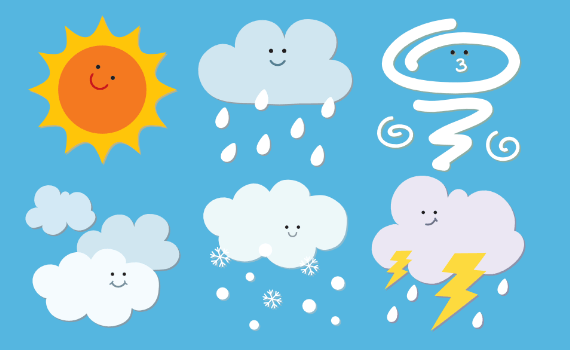
Weather

Natural Disasters

Experiments

Kid's Zone
Sink Holes
What are sinkholes?
Sinkholes are pits in the ground that form in areas where water gathers without external drainage. Sinkholes mainly occur as water drains below ground. It can dissolve subterranean caverns, particularly in areas where the bedrock is made of water-soluble evaporate rocks such as salt or gypsum or of carbonate rocks such as limestone or dolomite.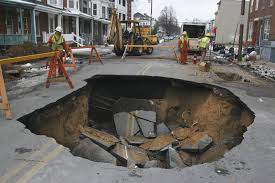
What causes sinkholes?
Sinkholes can be natural or man made. Natural sinkholes occur due to erosion or underground water. They start developing long time before it actually appears. The ground beneath our feet is not as much of a solid structure as we think it is. The ground is made from dirt, along with many rocks and minerals. There is water continually seeping in between the mud, rocks and minerals, as it makes its way down to the ground water reservoirs. As this happens, the water slowly erodes the rocks and minerals. Sometimes the flow of water increases to a point when it washes away the underground structure of the land. And when the structure becomes too weak to support the surface of the earth, it collapses and opens up a hole. This is how sinkholes are formed.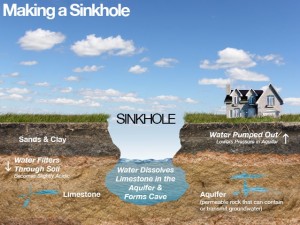
What type of bedrock is more susceptible to sinkholes?
Areas that have a bedrock made of limestone, salt deposits or carbonate rock are most susceptible to erosion and the formation of such holes. These rocks tend to erode as acidic water passes through them. When rainwater passes through decaying plant debris, it tend to become more acidic. Over a period of years, overlying sediments collapse and a sinkhole develops. Sometimes the holes are small, measuring a few feet wide and ten to fifteen feet deep. Others can be hundreds of miles wide and deep. However, all of them can be dangerous for those that get caught in them. There are three major kinds of sinkholes. Their formation is determined by the same geological processes, barring a few differences.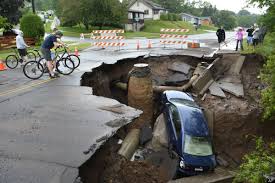
Can humans cause sinkholes?
Yes! Humans are also responsible for the formation of sinkholes. Activities like drilling, mining, construction, broken water or drain pipes, improperly compacted soil after excavation work or even heavy traffic can result in small to large sinkholes. Water from broken pipe can penetrate through mud and rocks and erode the ground underneath and cause sinkholes. Sometimes, heavy weight on soft soil can result in collapse of ground, resulting in a sinkhole. Sinkholes can also form when the land surface is changed.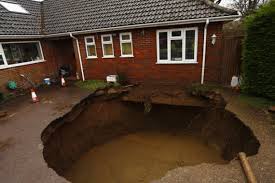
How quickly do sinkholes form?
Most of the time, sinkholes form gradually. Occasionally, though, the collapse is sudden. Those sudden sinkholes are often the ones that open up and swallow cars, homes and streets.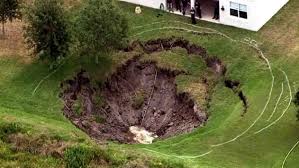
Why are there so many sinkholes?
Most of the sinkholes we are seeing at the moment are at least indirectly created by human activity. They’re occuring just to the sides of human constructions where rain water has been concentrated on a particular patch of ground in the form of run-off from roofs and tarmac. However, these local factors wouldn’t matter if it wasn’t for the wider picture. The Southeast, where most of the sinkholes have appeared, has not only suffered one of the wettest winters in recent decades, but is also natural sinkhole country as most of the bedrock is the soluble chalk.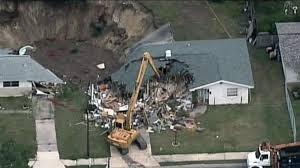
What are some notable sinkholes?
In 2010 one of the most devastating sinkholes in recent times hit Guatemala City. An area approximately 65ft wide and 100ft deep collapsed, swallowing a three-story factory and killing 15 people. The sinkhole was caused by a number of factors including an influx of water from Tropical Storm Agatha and leakage from a local sewerage pipe.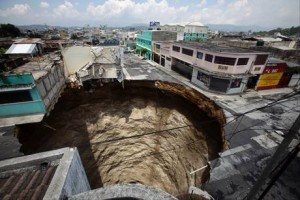
On February 12, 2014, a sinkhole some 40ft wide and 20ft deep opened under the floor of the Skydome area of the National Corvette Museum causing a portion of the floor to collapse. Eight rare and one-of-a-kind Corvettes, portions of the display stands and rails, large concrete floor slabs and dirt fell into the sinkhole, causing serious damage to some of the Corvettes. The Corvettes involved have an estimated value of a million dollars.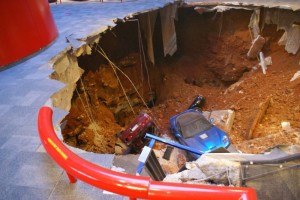
Do sinkholes happen in other parts of the world?
Yes! The deepest we know about is the Xiaozhai tiankeng in China. Tiankeng is the local term for large sinkholes and translates literally as ‘heavenly pit’. This particular example in the Chongqing district is a staggering 662m deep and 626m wide.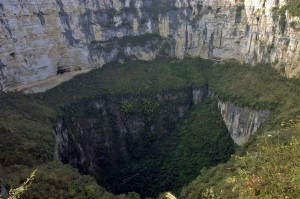
Other notable sinkholes include Sima Humboldt in Bolivia, a crater 314m deep and formed from extremely resistant sandstone.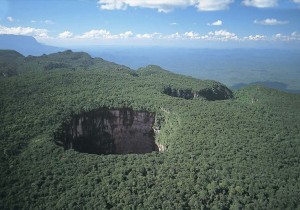
The Great Blue Hole in Belize, a perfectly round hole in the middle of an atoll which is 124m deep.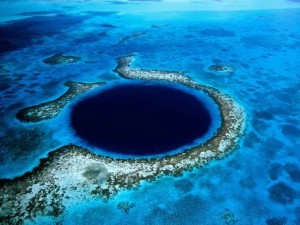
Finally, Crveno Jezero in Croatia, a 530m deep sinkhole with nearly vertical walls.
How many types of sinkholes are there?
The three major types of sinkholes know to us are : Solution, Cover Collapse and Cover Subsidence.
Solution sinkholes are most commonly seen in areas that have a very thin cover of soil on the surface, exposing the bedrock below to continual erosion by water. As the water percolates through the bedrock, it carries away small parts of the rock with it. As the bedrock erodes, particles collect in the spaces it leaves. Over a period of time, a small depression is formed. It is at this point where the hole forms. The hole is usually bowl shaped and can be quite large. Sometimes the bedrock may collapse all of a sudden to form such a solution sinkhole and other times it happens over time.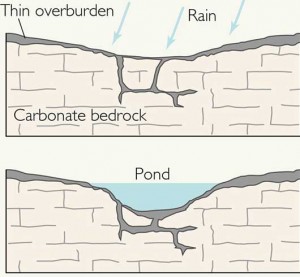
The second kind of sinkholes are known as Cover Collapse sinkhole. These take place when the bedrock is covered by a deep layer of soil and earth. Once the bedrock begins to get eroded, crack start forming in the rocky areas around it. When this happens, a number of weak points begin to form in the layers of soil and strata above it. Finally, it comes to a point when the weak points become a large hole within the bedrock that cannot support the weight above it. The cover collapse usually happens in a sudden manner and can create large holes in a matter of minutes.
The last kind of sinkholes are known as Cover Subsidence Sinkhole. In this case, the hole is formed over a period of time. The bedrock here is covered by soil and materials which are not well knitted together. Areas that have soil comprising largely of clay or sand often face the occurrence of this hole. Once the bedrock starts to erode, the clay or sand starts permeating through the cracks and settles into the spaces left behind. Over time, this creates a cavity on the surface of the soil and not under it.
Lesson Plan: Here is a great lesson plan on the science of a sinkhole.
Lesson Plan: This is a fun lesson plan where kids can make a sinkhole in a cup.
Lesson Plan: Here is a great lesson plan on how sinkholes form.
Science Fair Project Ideas: Here is a complete list of science fair project ideas. Discover the science behind the weather that impacts us every day.
